Links between Teleconnection Patterns and Water Level Regime of Selected Polish Lakes
Abstract
1. Introduction
2. Materials and Methods
3. Results
3.1. Arctic Oscillation
3.2. North Atlantic Oscillation
3.3. East Atlantic Pattern
3.4. Scandinavian Pattern
3.5. Effect of Teleconnection Patterns on Air Temperature and Precipitation
4. Discussion
5. Conclusions
Author Contributions
Funding
Conflicts of Interest
References
- Wrzesiński, D.; Ptak, M.; Plewa, K. Effect of the North Atlantic Oscillation on water level fluctuations in lakes of northern Poland. Geographia Polonica 2018, 91, 243–259. [Google Scholar] [CrossRef]
- Schaefer, K.; Denning, A.S.; Leonard, O. The winter Arctic Oscillation and the timing of snowmelt in Europe. Geophys. Res. Lett. 2004, 31. [Google Scholar] [CrossRef]
- Jevrejeva, S.; Moore, J.C.; Grinsted, A. Influence of the Arctic Oscillation and El Niño-Southern Oscillation (ENSO) on ice conditions in the Baltic Sea: The wavelet approach. J. Geophys. Res. Atmos. 2003, 108. [Google Scholar] [CrossRef]
- Wang, D.; Wang, C.; Yang, X.; Lu, J. Winter Northern Hemisphere surface air temperature variability associated with the Arctic Oscillation and North Atlantic Oscillation. Geophys. Res. Lett. 2005, 32. [Google Scholar] [CrossRef]
- Trigo, R.M.; Osborn, T.J.; Corte-Real, J.M. The North Atlantic Oscillation influence on Europe: Climate impacts and associated physical mechanisms. Clim. Res. 2002, 20, 9–17. [Google Scholar] [CrossRef]
- Hurrell, J.W.; Kushnir, Y.; Ottersen, G.; Visbeck, M. An overview of the North Atlantic oscillation. In The North Atlantic Oscillation, Hurrell, J.W.; Kushnir, Y., Ottersen, G., Visbeck, M., Eds.; American Geophysical Union (AGU): Washington, DC, USA, 2003. [Google Scholar] [CrossRef]
- Trigo, R.M.; Pozo-Vázquez, D.; Osborn, T.J.; Castro-Díez, Y.; Gámiz-Fortis, S.; Esteban-Parra, M.J. North Atlantic Oscillation influence on precipitation, river flow and water resources in the Iberian Peninsula. Int. J. Climatol. 2004, 24, 925–944. [Google Scholar] [CrossRef]
- Moore, G.W.K.; Renfrew, I.A. Cold European winters: Interplay between the NAO and the East Atlantic mode. Atmos. Sci. Lett. 2012, 13, 1–8. [Google Scholar] [CrossRef]
- Knežević, S.; Tošić, I.; Unkašević, M.; Pejanović, G. The influence of the East Atlantic Oscillation to climate indices based on the daily minimum temperatures in Serbia. Theor. Appl. Climatol. 2014, 116, 435–446. [Google Scholar] [CrossRef]
- Casanueva, A.; Rodríguez-Puebla, C.; Frías, M.D.; González-Reviriego, N. Variability of extreme precipitation over Europe and its relationships with teleconnection patterns. Hydrol. Earth Syst. Sci. 2014, 18, 709–725. [Google Scholar] [CrossRef]
- Bednorz, E.; Wibig, J. Snow depth in eastern Europe in relation to circulation patterns. Ann. Glaciol. 2008, 48, 135–149. [Google Scholar] [CrossRef][Green Version]
- Comas-Bru, L.; Mcdermott, F. Impacts of the EA and SCA patterns on the European twentieth century NAO—Winter climate relationship. Q. J. R. Meteorolog. Soc. 2014, 140, 354–363. [Google Scholar] [CrossRef]
- Higgins, R.W.; Leetmaa, A.; Kousky, V.E. Relationships between climate variability and winter temperature extremes in the United States. J. Clim. 2002, 15, 1555–1572. [Google Scholar] [CrossRef]
- Barnston, A.G.; Livezey, R.E. Classification, seasonality and persistence of low-frequency atmospheric circulation patterns. Mon Weather Rev. 1987, 115, 1083–1126. [Google Scholar] [CrossRef]
- Wibig, J. Precipitation in Europe in relation to circulation patterns at the 500 hPa level. Int. J. Climatol. 1999, 19, 253–269. [Google Scholar] [CrossRef]
- Tomczyk, A.M. Impact of macro-scale circulation types on the occurrence of frosty days in Poland. Bull. Geogr. Phys. Geog. Ser. 2015, 9, 55–65. [Google Scholar] [CrossRef]
- Tomczyk, A.M.; Szyga-Pluta, K.; Bednorz, E. The effect of macro-scale circulation types on the length of the growing season in Poland. Meteorol. Atmos. Phys. 2018, 1–11. [Google Scholar] [CrossRef]
- Ptak, M.; Tomczyk, A.; Wrzesiński, D. Effect of teleconnection patterns on changes in water temperature in Polish lakes. Atmosphere 2018, 9, 66. [Google Scholar] [CrossRef]
- Bednorz, E. Snow cover in western Poland and macro-scale circulation conditions. Int. J. Climatol. 2002, 22, 533–541. [Google Scholar] [CrossRef]
- Bednorz, E. Snow cover in eastern Europe in relation to temperature, precipitation and circulation. Int. J. Climatol. 2004, 24, 591–601. [Google Scholar] [CrossRef]
- Skowron, R. Changeability of the ice cover on the lakes of northern Poland in the light of climatic changes. Bull. Geogr. Phys. Geog. Ser. 2009, 1, 103–123. [Google Scholar] [CrossRef]
- Girjatowicz, J.P. Effects of the North Atlantic Oscillation on water temperature in southern Baltic coastal lakes. Annales de Limnologie—Int. J. Limnol. 2011, 47, 73–84. [Google Scholar] [CrossRef]
- Bernhardt, J.; Engelhardt, C.; Kirillin, G.; Matschullat, J. Lake ice phenology in Berlin-Brandenburg from 1947–2007: Observations and model hindcasts. Clim. Change 2012, 112, 791–817. [Google Scholar] [CrossRef]
- Wrzesiński, D.; Choiński, A.; Ptak, M. Effect of the North Atlantic Oscillation on the thermal characteristics of lakes in Poland. Act. Geophys. 2015, 63, 863–883. [Google Scholar] [CrossRef]
- Wrzesiński, D.; Choiński, A.; Ptak, M.; Skowron, R. Effect of the North Atlantic Oscillation on the Pattern of Lake Ice Phenology in Poland. Act. Geophys. 2015, 63, 1664–1684. [Google Scholar] [CrossRef]
- Górniak, A.; Piekarski, K. Seasonal and multiannual changes of water levels in lakes of northeastern Poland. Pol. J. Environ. Stud. 2002, 11, 349–354. [Google Scholar]
- Wrzesiński, D.; Ptak, M. Water level changes in Polish lakes during 1976–2010. J. Geog. Sci. 2016, 26, 83–101. [Google Scholar] [CrossRef]
- Wrzesiński, D.; Plewa, K. Stability of the water levels regime on the lakes in Poland. Badania Fizjograficzne Seria A Geografia Fizyczna 2016, A67, 305–316. [Google Scholar] [CrossRef]
- Plewa, K.; Wrzesiński, D. Wpływ Oscylacji Północnoatlantyckiej na zmiany stabilności reżimu stanów wody jezior w Polsce. Badania Fizjograficzne Seria A Geografia Fizyczna 2017, A68, 127–138. [Google Scholar] [CrossRef]
- Wrzesiński, D.; Ptak, M. An investigation of water level fluctuations in Polish lakes in various phases of the winter North Atlantic Oscillation. Geol. Geophys. Environ. 2017, 43. [Google Scholar] [CrossRef]
- Assel, R.; Rodionov, S. Atmospheric teleconnections for annual maximum ice cover on the Laurentian Great Lakes. Int. J. Climatol. 1998, 18, 425–442. [Google Scholar] [CrossRef]
- Ghanbari, R.N.; Bravo, H.R. Coherence between atmospheric teleconnections, Great Lakes water levels, and regional climate. Adv. Water Resour. 2008, 31, 1284–1298. [Google Scholar] [CrossRef]
- Wang, J.; Bai, X.; Hu, H.; Clites, A.; Colton, M.; Lofgren, B. Temporal and spatial variability of Great Lakes ice cover, 1973–2010. J. Clim. 2012, 25, 1318–1329. [Google Scholar] [CrossRef]
- Biron, S.; Assani, A.A.; Frenette, J.J.; Massicotte, P. Comparison of Lake Ontario and St. Lawrence River hydrologic droughts and their relationship to climate indices. Water Resour. Res. 2014, 50, 1396–1409. [Google Scholar] [CrossRef]
- Assani, A.A.; Landry, R.; Azouaoui, O.; Massicotte, P.; Gratton, D. Comparison of the characteristics (frequency and timing) of drought and wetness indices of annual mean water levels in the five North American Great Lakes. Water Resour. Manag. 2016, 30, 359–373. [Google Scholar] [CrossRef]
- Hewitt, B.; Lopez, L.; Gaibisels, K.; Murdoch, A.; Higgins, S.; Magnuson, J.; Paterson, A.; Rusak, J.; Yao, H.; Sharma, S. Historical trends, drivers, and future projections of ice phenology in small north temperate lakes in the Laurentian Great Lakes Region. Water 2018, 10, 70. [Google Scholar] [CrossRef]
- Fu, W.; Steinschneider, S. A Diagnostic-Predictive Assessment of Winter Precipitation over the Laurentian Great Lakes: Effects of ENSO and Other Teleconnections. J. Hydrometeorol. 2019, 20, 117–137. [Google Scholar] [CrossRef]
- Ghanbari, R.N.; Bravo, H.R.; Magnuson, J.J.; Hyzer, W.G.; Benson, B.J. Coherence between lake ice cover, local climate and teleconnections (Lake Mendota, Wisconsin). J. Hydrol. 2009, 374, 282–293. [Google Scholar] [CrossRef]
- Wang, H.; Pan, Y.; Chen, Y. Impacts of regional climate and teleconnection on hydrological change in the Bosten Lake Basin, arid region of northwestern China. J. Water Clim. Chang. 2018, 9, 74–88. [Google Scholar] [CrossRef]
- Belete, M.; Diekkrüger, B.; Roehrig, J. Linkage between water level dynamics and climate variability: The case of Lake Hawassa hydrology and ENSO phenomena. Climate 2017, 5, 21. [Google Scholar] [CrossRef]
- Choiński, A. Katalog jezior Polski; Wydawnictwo Naukowe Uniwersytetu im; Adama Mickiewicza: Poznań, Poland, 2006. [Google Scholar]
- Alexandersson, H.; Moberg, A. Homogenization of Swedish temperature data. Part I: Homogeneity test for linear trends. Int. J. Climatol. 1997, 17, 25–34. [Google Scholar] [CrossRef]
- Khaliq, M.N.; Ouarda, T.B. Short Communication on the critical values of the standard normal homogeneity test (SNHT). Int. J. Climatol. 2007, 27, 681–687. [Google Scholar] [CrossRef]
- Salmi, T.; Määttä, A.; Anttila, P.; Ruoho-Airola, T.; Amnell, T. Detecting Trends of Annual Values of Atmospheric Pollutants by the Mann-Kendall Test and Sen’s Slope Estimates—The Excel Template Application MAKESENS; Finnish Meteorological Institute: Helsinki, Finland, 2002. [Google Scholar]
- Niedźwiedź, T.; Twardosz, R.; Walanus, A. Long-term variability of precipitation series in east central Europe in relation to circulation patterns. Theor. Appl. Climatol. 2009, 98, 337–350. [Google Scholar] [CrossRef]
- Rust, H.W.; Richling, A.; Bissolli, P.; Ulbrich, U. Linking teleconnection patterns to European temperature—A multiple linear regression model. Meteorol. Z. 2015, 24, 411–423. [Google Scholar] [CrossRef]
- Plewa, K.; Wrzesiński, D.; Ptak, M. Reżim stanów wody wybranych jezior Pojezierza Wielkopolsko-Kujawskiego. Badania Fizjograficzne Seria A—Geografia Fizyczna 2015, A66, 131–142. [Google Scholar] [CrossRef]
- Plewa, K. Typy przebiegu pentadowych współczynników stanu wody jezior Niżu Polskiego. Badania Fizjograficzne Seria A—Geografia Fizyczna 2018, A69, 161–177. [Google Scholar]
- Czarnecka, H. Atlas podziału hydrograficznego Polski: Zestawienia zlewni; Instytut Meteorologii i Gospodarki Wodnej: Warszawa, Poland, 2005. [Google Scholar]
- Ward, J.H. Hierarchical grouping to optimize an objective function. J. Am. Stat. Assoc. 1963, 58, 236–244. [Google Scholar] [CrossRef]
- Berhanu, B.; Seleshi, Y.; Demisse, S.; Melesse, A. Flow regime classification and hydrological characterization: A case study of Ethiopian rivers. In Water; 2015; Volume 7, pp. 3149–3165. [Google Scholar]
- Isik, S.; Turan, A.; Dogan, E. Classification of river yields in Turkey with cluster analysis. Presented at EWRI 2006 World Environmental and Water Resources Congress, Omaha, NE, USA, 21–35 May 2006. [Google Scholar]
- Isik, S.; Singh, V.P. Hydrologic regionalization of watersheds in Turkey. J. Hydrol. Eng. 2008, 13, 824–834. [Google Scholar] [CrossRef]
- Mishra, S.; Saravanan, C.; Dwivedi, V.K.; Pathak, K.K. Discovering flood recession pattern in hydrological time series data mining during the post monsoon period. Int. J. Comput. Appl. Technol. 2014, 90, 35–44. [Google Scholar] [CrossRef][Green Version]
- Zhang, Y.; Arthington, A.H.; Bunn, S.E.; Mackay, S.; Xia, J.; Kennard, M. Classification of flow regimes for environmental flow assessment in regulated rivers: The Huai River Basin, China. River Res. Appl. 2012, 28, 989–1005. [Google Scholar] [CrossRef]
- Jeneiová, K.; Kohnová, S.; Sabo, M. Detecting trends in the annual maximum discharges in the Vah River Basin, Slovakia. Acta Silvatica et Lignaria Hungarica 2014, 10, 133–144. [Google Scholar] [CrossRef]
- Firat, M.; Dikbas, F.; Koç, A.C.; Gungor, M. Missing data analysis and homogeneity test for Turkish precipitation series. Sadhana 2010, 35, 707. [Google Scholar] [CrossRef]
- Bormann, H.; Pinter, N.; Elfert, S. Hydrological signatures of flood trends on German rivers: Flood frequencies, flood heights and specific stages. J. Hydrol. 2011, 404, 50–66. [Google Scholar] [CrossRef]
- Fathian, F.; Dehghan, Z.; Bazrkar, M.H.; Eslamian, S. Trends in hydrological and climatic variables affected by four variations of the Mann-Kendall approach in Urmia Lake basin, Iran. Hydrol. Sci. J. 2016, 61, 892–904. [Google Scholar] [CrossRef]
- Mello, C.R.D.; Norton, L.D.; Curi, N.; Yanagi, S.N.M. Sea surface temperature (SST) and rainfall erosivity in the Upper Grande River Basin, Southeast Brazil. Ciência e Agrotecnologia 2012, 36, 53–59. [Google Scholar] [CrossRef]
- Nõges, T.; Nõges, P.; Laugaste, R. Water level as the mediator between climate change and phytoplankton composition in a large shallow temperate lake. Hydrobiologia 2003, 506, 257–263. [Google Scholar] [CrossRef]
- Soja, G.; Züger, J.; Knoflacher, M.; Kinner, P.; Soja, A.M. Climate impacts on water balance of a shallow steppe lake in Eastern Austria (Lake Neusiedl). J. Hydrol. 2013, 480, 115–124. [Google Scholar] [CrossRef]
- Sheida, J.; Hamidi, S.A.; Ghanbari, R.N. Climate variability and anthropogenic effects on Lake Urmia water level fluctuations, northwestern Iran. Hydrol. Sci. J. 2016, 61, 1759–1769. [Google Scholar] [CrossRef]
- Krupa, E.; Slyvinskiy, G.; Barinova, S. The Effect of Climatic Factors on the Long-term Dynamics of Aquatic Ecosystem of the Balkhash Lake (Kazakhstan, Central Asia). Adv. Stud. Biol. 2014, 6, 3. [Google Scholar] [CrossRef]
- Lorenzo-Lacruz, J.; Vicente-Serrano, S.M.; López-Moreno, J.I.; González-Hidalgo, J.C.; Morán-Tejeda, E. The response of Iberian rivers to the North Atlantic Oscillation. Hydrol. Earth Syst. Sci. 2011, 15, 2581–2597. [Google Scholar] [CrossRef]
- Fleming, S.W.; Dahlke, H.E. Parabolic northern-hemisphere river flow teleconnections to El Niño-Southern Oscillation and the Arctic Oscillation. Environ. Res. Lett. 2014, 9. [Google Scholar] [CrossRef]
- Enfield, D.B.; Mestas-Nuñez, A.M.; Trimble, P.J. The Atlantic multidecadal oscillation and its relation to rainfall and river flows in the continental US. Geophys. Res. Lett. 2001, 28, 2077–2080. [Google Scholar] [CrossRef]
- Rogers, J.C.; Coleman, J.S. Interactions between the Atlantic Multidecadal Oscillation, El Nino/La Nina, and the PNA in winter Mississippi valley stream flow. Geophys. Res. Lett. 2003, 30. [Google Scholar] [CrossRef]
- Ionita, M.; Chelcea, S.; Rimbu, N.; Adler, M.J. Spatial and temporal variability of winter streamflow over Romania and its relationship to large-scale atmospheric circulation. J. Hydrol. 2014, 519, 1339–1349. [Google Scholar] [CrossRef]
- Marsz, A.A.; Styszyńska, A. Oscylacja Północnego Atlantyku a temperatura powietrza nad Polską; Wydaw Uczelniane WSM: Warsaw, Poland, 2001. [Google Scholar]
- Kożuchowski, K.; Degirmendžic, J. Wskaźniki cyrkulacji a temperatura powietrza w Polsce. In Oscylacja Północnego Atlantyku i jej rola w kształtowaniu zmienności warunków klimatycznych i hydrologicznych Polski; Marsz, A.A., Styszyńska, A., Eds.; Akad Morska: Gdynia, Poland, 2002. [Google Scholar]
- Niedźwiedź, T. Relacje między NAO a wskaźnikami cyrkulacji nad Polską. In Oscylacja Północnego Atlantyku i jej rola w kształtowaniu zmienności warunków klimatycznych i hydrologicznych Polski; Marsz, A.A., Styszyńska, A., Eds.; Akad Morska: Gdynia, Poland, 2002. [Google Scholar]
- Przybylak, R.; Wójcik, G.; Marciniak, K. Wpływ Oscylacji Północnoatlantyckiej i Arktycznej na warunki termiczne chłodnej pory roku w Polsce w XVI–XX wiekach. Przegl. Geofiz 2003, 1–2, 61–74. [Google Scholar]
- Styszyńska, A. Oscylacja Północnego Atlantyku a opady na obszarze Polski. Pr Stud. Geogr. 2001, 29, 232–241. [Google Scholar]
- Wibig, J. Wpływ cyrkulacji atmosferycznej na rozkład przestrzenny anomalii temperatury i opadów w Europie; Wydawnictwo UŁ: Łódź, Poland, 2001. [Google Scholar]
- Bryś, K.; Bryś, T. Wpływ Oscylacji Północnoatlantyckiej na zmienność warunków wilgotnościowych, radiacyjnych, dynamicznych i ewaporacyjnych we Wrocławiu-Swojcu w latach 1946–2000. In Oscylacja Północnego Atlantyku i jej rola w kształtowaniu zmienności warunków klimatycznych i hydrologicznych Polski; Marsz, A.A., Styszyńska, A., Eds.; Akad Morska: Gdynia, Poland, 2002. [Google Scholar]
- Falarz, M. Snow cover variability in Poland in relations to macro- and mesoscale atmospheric circulation in the twentieth century. Int. J. Climatol. 2007, 27, 2069–2081. [Google Scholar] [CrossRef]
- Bednorz, E. Wpływ sytuacji barycznych na występowanie pokrywy śnieżnej na obszarach nizinnych środkowej Europy; Wydawnictwo Naukowe UAM: Poznań, Poland, 2009. [Google Scholar]
- Kaczmarek, Z. Wpływ Oscylacji Północnoatlantyckiej na przepływy rzek europejskich. In Oscylacja Północnego Atlantyku i jej rola w kształtowaniu zmienności warunków klimatycznych i hydrologicznych Polski; Marsz, A.A., Styszyńska, A., Eds.; Akad Morska: Gdynia, Poland, 2002. [Google Scholar]
- Kaczmarek, Z. The Impact Climate Variability on Flood Risk in Poland. Risk Anal. 2003, 23, 559–566. [Google Scholar] [CrossRef]
- Styszyńska, A. Związki między przepływem Warty w Poznaniu a zimowymi wskaźnikami NAO w okresie 1865–2000. In Oscylacja Północnego Atlantyku i jej rola w kształtowaniu zmienności warunków klimatycznych i hydrologicznych Polski; Marsz, A.A., Styszyńska, A., Eds.; Akad Morska: Gdynia, Poland, 2002. [Google Scholar]
- Styszyńska, A.; Tamulewicz, J. Warta river discharges in Poznań and atmospheric circulation in the North Atlantic region. Quaestiones Geographicae 2004, 23, 61–81. [Google Scholar]
- Pociask-Karteczka, J.; Nieckarz, Z.; Limanówka, D. The North Atlantic Oscillation impact on hydrological regime in Polish Carpathians. In Interdisciplinary Approaches in Small Catchment Hydrology: Monitoring and Research; FRIEND International Conference: Demanovska Dolina, Slovakia, 2002; p. 225230. [Google Scholar]
- Pociask-Karteczka, J.; Limanówka, D.; Nieckarz, Z. Wpływ Oscylacji Północnoatlantyckiej na przepływy rzek karpackich (1951–2000). Fol. Geogr. Ser. Geographia-Physica 2002–2003, 33–34, 89–104. [Google Scholar]
- Wrzesiński, D. Regional differences in the influence of the North Atlantic Oscillation on seasonal river runoff in Poland. Quaestiones Geographicae 2011, 30, 127–136. [Google Scholar] [CrossRef]
- Wrzesiński, D.; Paluszkiewicz, R. Spatial differences in the impact of the North Atlantic Oscillation on the flow of rivers in Europe. Hydrol. Res. 2011, 42, 30–39. [Google Scholar] [CrossRef]
- Wrzesiński, D.; Ptak, M.; Baczyńska, A. Effect of the North Atlantic Oscillation on ice phenomena on selected lakes in Poland over the years 1961–2010. Quaestiones Geographicae 2013, 32, 119–128. [Google Scholar] [CrossRef]
- Plewa, K.; Wrzesiński, D.; Baczyńska, A. Przestrzenne i czasowe zróżnicowanie amplitud stanów wody jezior w Polsce w latach 1981–2015. Badania Fizjograficzne Seria A—Geografia Fizyczna 2017, A68, 115–126. [Google Scholar] [CrossRef]
- Gurgul, P.; Syrek, R. Zastosowanie mieszanki kopul do modelowania współzależności pomiędzy wybranymi sektorami gospodarki. Ekonomia Menedżerska 2009, 6, 129–139. [Google Scholar]
- Huang, T.; Ligang, X.; Hongxiang, F. Drought Characteristics and Its Response to the Global Climate Variability in the Yangtze River Basin, China. Water 2019, 11, 13. [Google Scholar] [CrossRef]
- Wang, W.C.; Chau, K.W.; Qiu, L.; Chen, Y.B. Improving forecasting accuracy of medium and long-term runoff using artificial neural network based on EEMD decomposition. Environ. Res. 2015, 139, 46–54. [Google Scholar] [CrossRef] [PubMed]
- Ghorbani, M.A.; Kazempour, R.; Chau, K.W.; Shamshirband, S.; Ghazvinei, P.T. Forecasting pan evaporation with an integrated artificial neural network quantum-behaved particle swarm optimization model: A case study in Talesh, Northern Iran. Eng. Appl. Comput. Fluid Mech. 2018, 12, 724–737. [Google Scholar] [CrossRef]
- Moazenzadeh, R.; Mohammadi, B.; Shamshirband, S.; Chau, K.W. Coupling a firefly algorithm with support vector regression to predict evaporation in northern Iran. Eng. Appl. Comput. Fluid Mech. 2018, 12, 584–597. [Google Scholar] [CrossRef]
- Wu, C.L.; Chau, K.W. Rainfall–runoff modeling using artificial neural network coupled with singular spectrum analysis. J. Hydrol. 2011, 399, 394–409. [Google Scholar] [CrossRef]
- Petty, T.R.; Dhingra, P. Streamflow Hydrology Estimate Using Machine Learning (SHEM). J. Am. Water Resour. Assoc. 2017, 54, 55–68. [Google Scholar] [CrossRef]
- Tian, Y.; Xu, Y.P.; Yang, Z.; Wang, G.; Zhu, Q. Integration of a Parsimonious Hydrological Model with Recurrent Neural Networks for Improved Streamflow Forecasting. Water 2018, 10, 1655. [Google Scholar] [CrossRef]
- Yaseen, Z.M.; Sulaiman, S.O.; Deo, R.C.; Chau, K.W. An enhanced extreme learning machine model for river flow forecasting: State-of-the-art, practical applications in water resource engineering area and future research direction. J. Hydrol. 2019, 569, 387–408. [Google Scholar] [CrossRef]
- Kowalczak, P.; Farat, R.; Kepinska-Kasprzak, M.; Kuznicka, M.; Mager, P. Hierarchy of aerial small water retention need. Materiały Badawcze Seria Gospodarka Wodna a Ochrona Wód 1997, 19, 90. [Google Scholar]
- Nowak, B.; Ptak, M. Potential use of lakes as a component of small retention in Wielkopolska. In Proceedings of the 10th Conference on Interdisciplinary Problems in Environmental Protection and Engineering EKO-DOK 2018, Polanica-Zdrój, Poland, 16–18 April 2018; EDP Sciences: Les Ulis, France, 2018. [Google Scholar] [CrossRef]
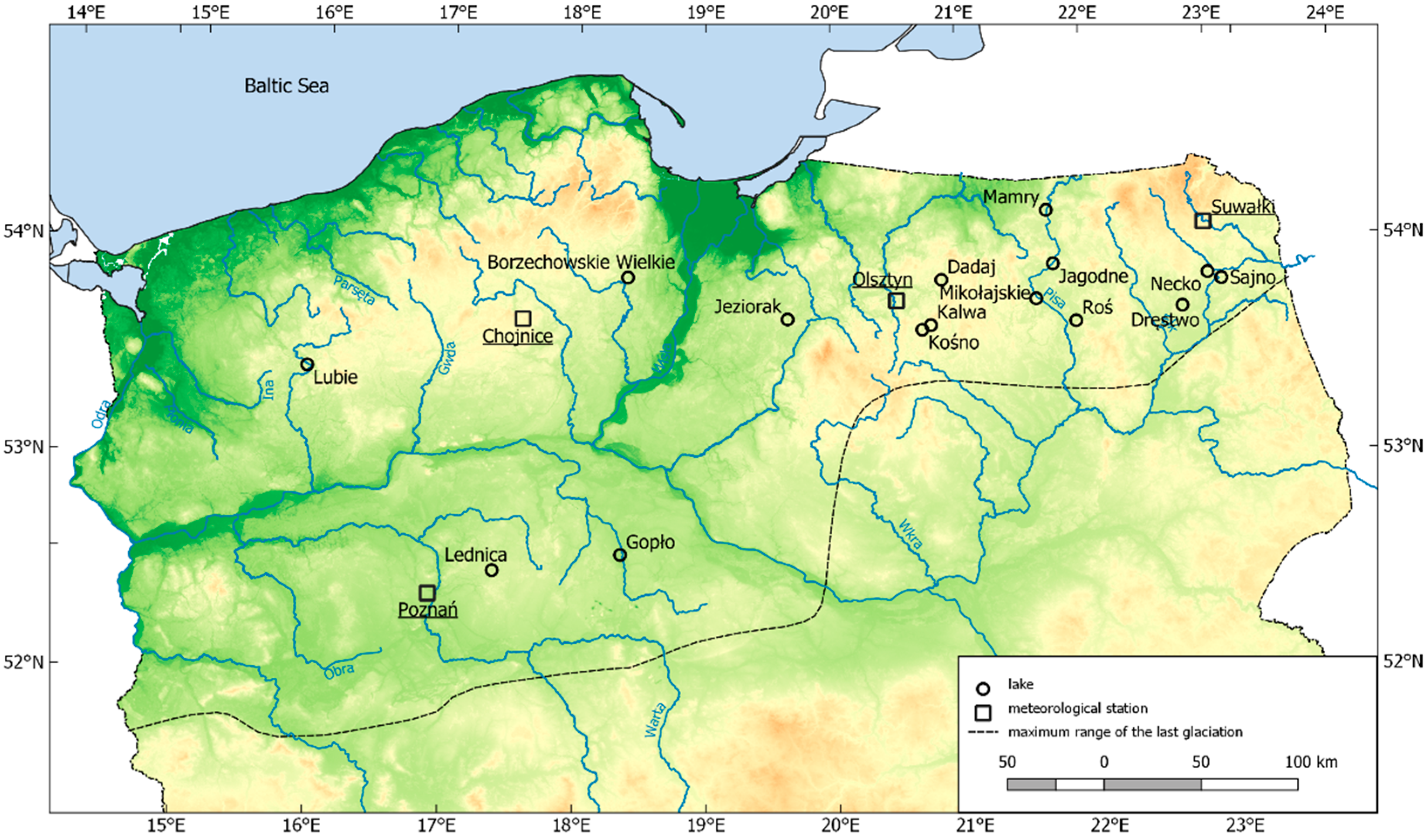
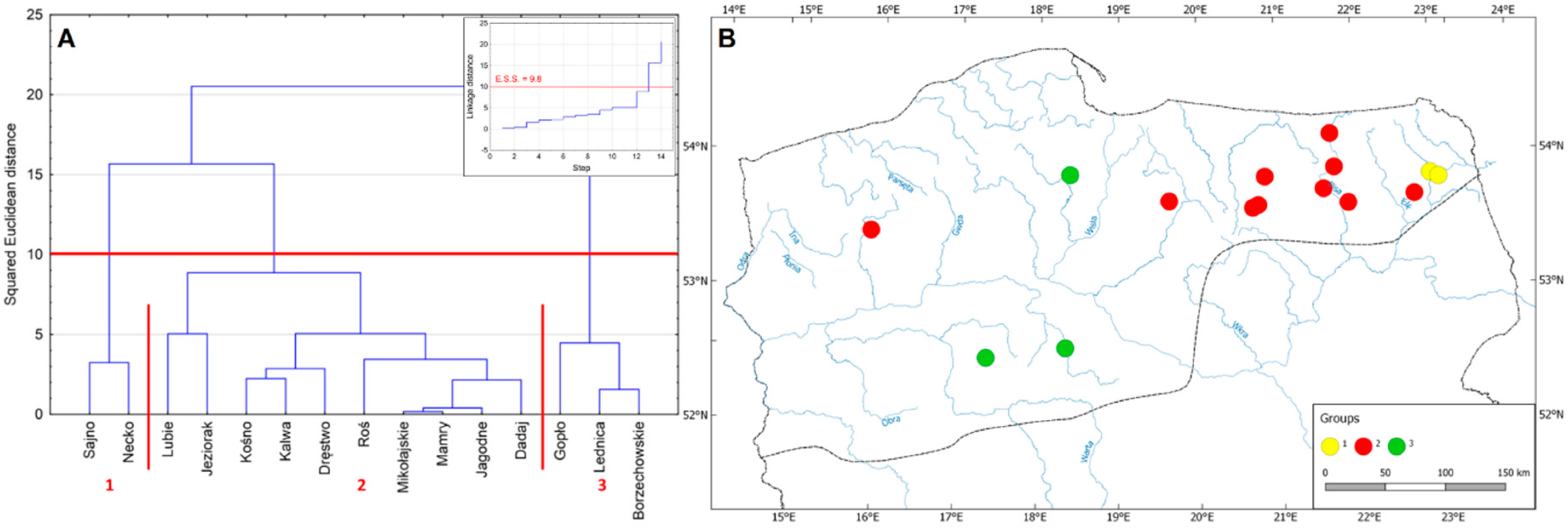
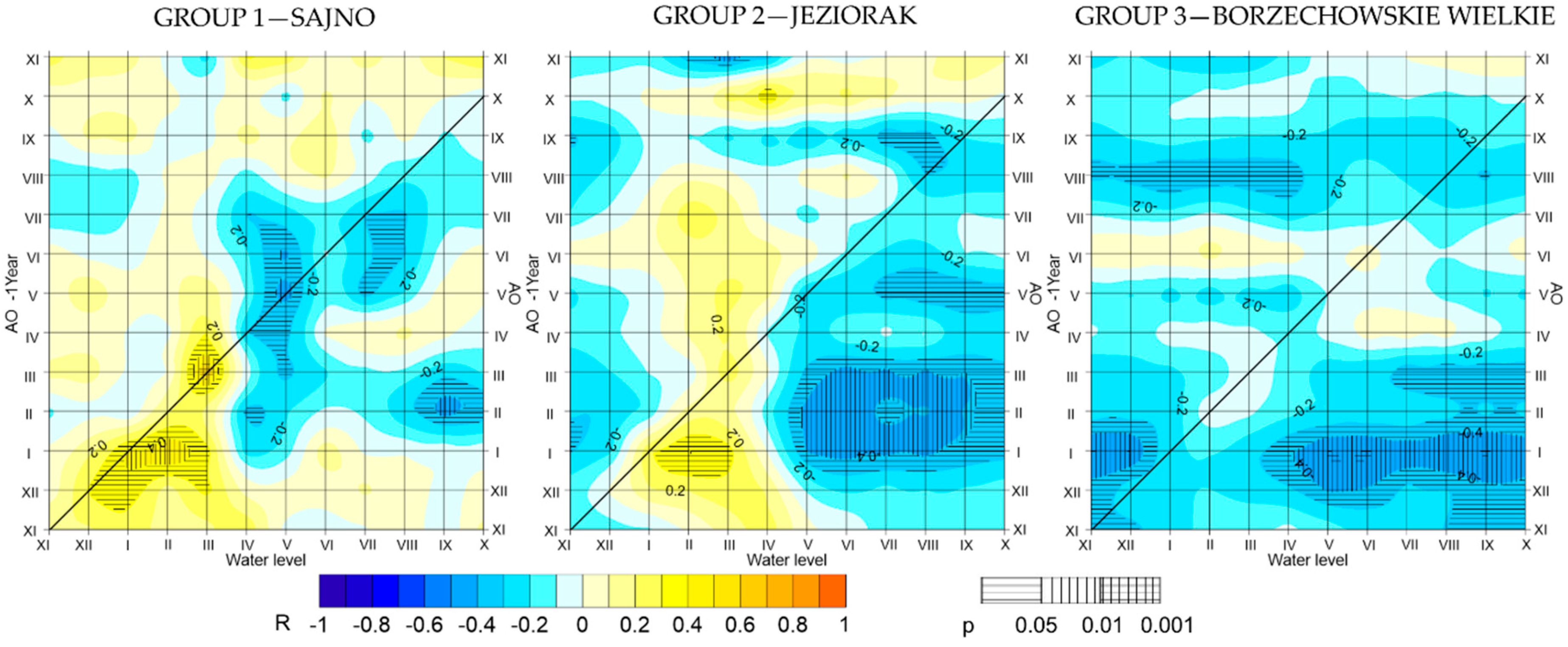
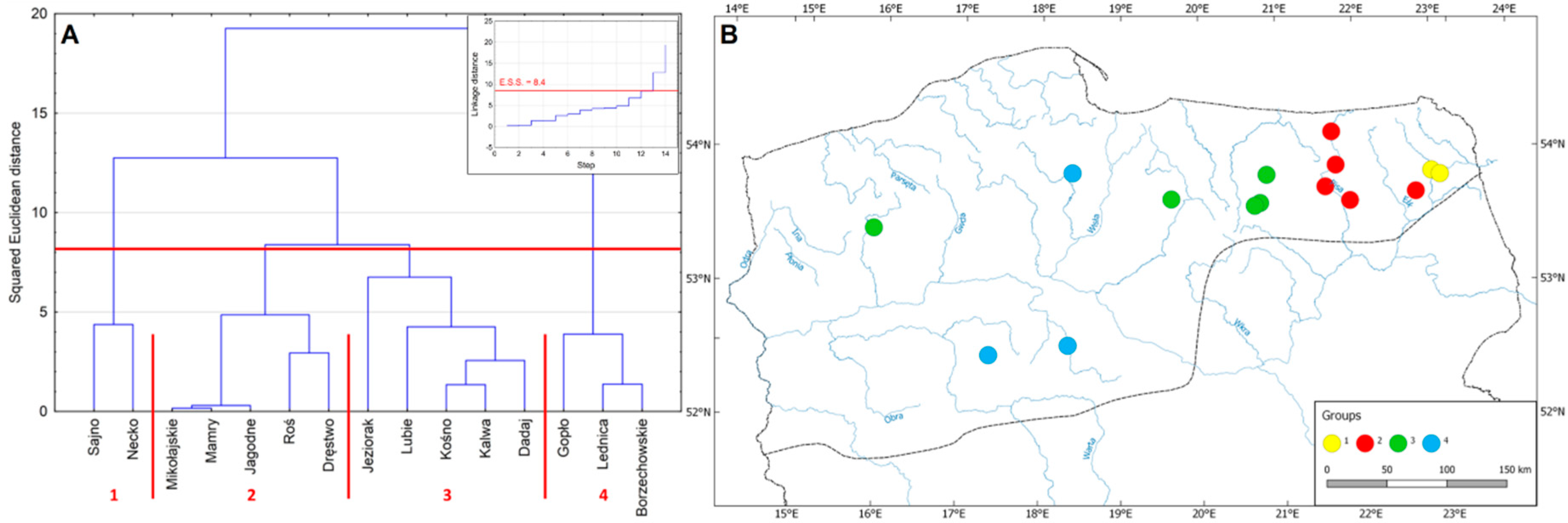
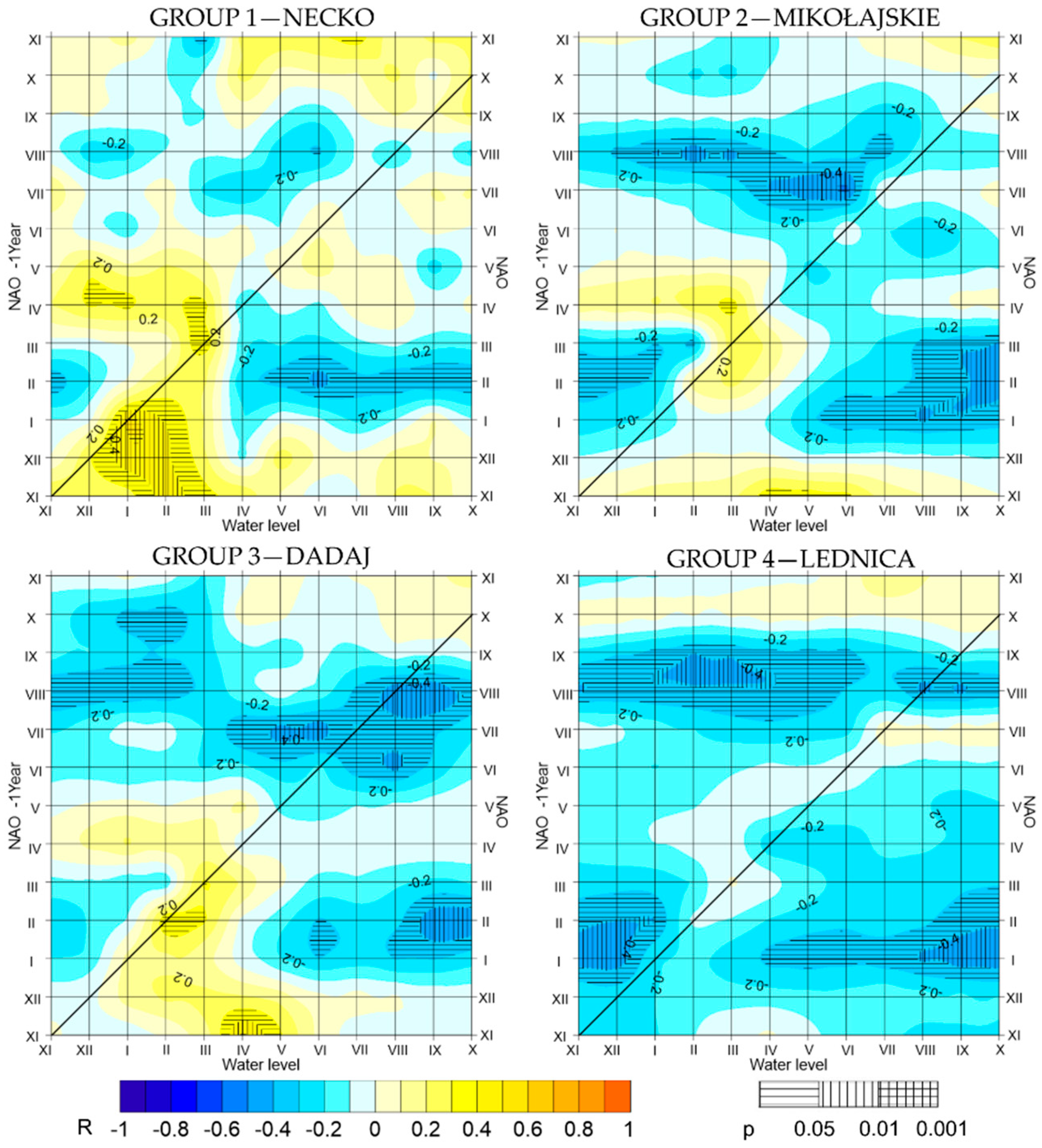

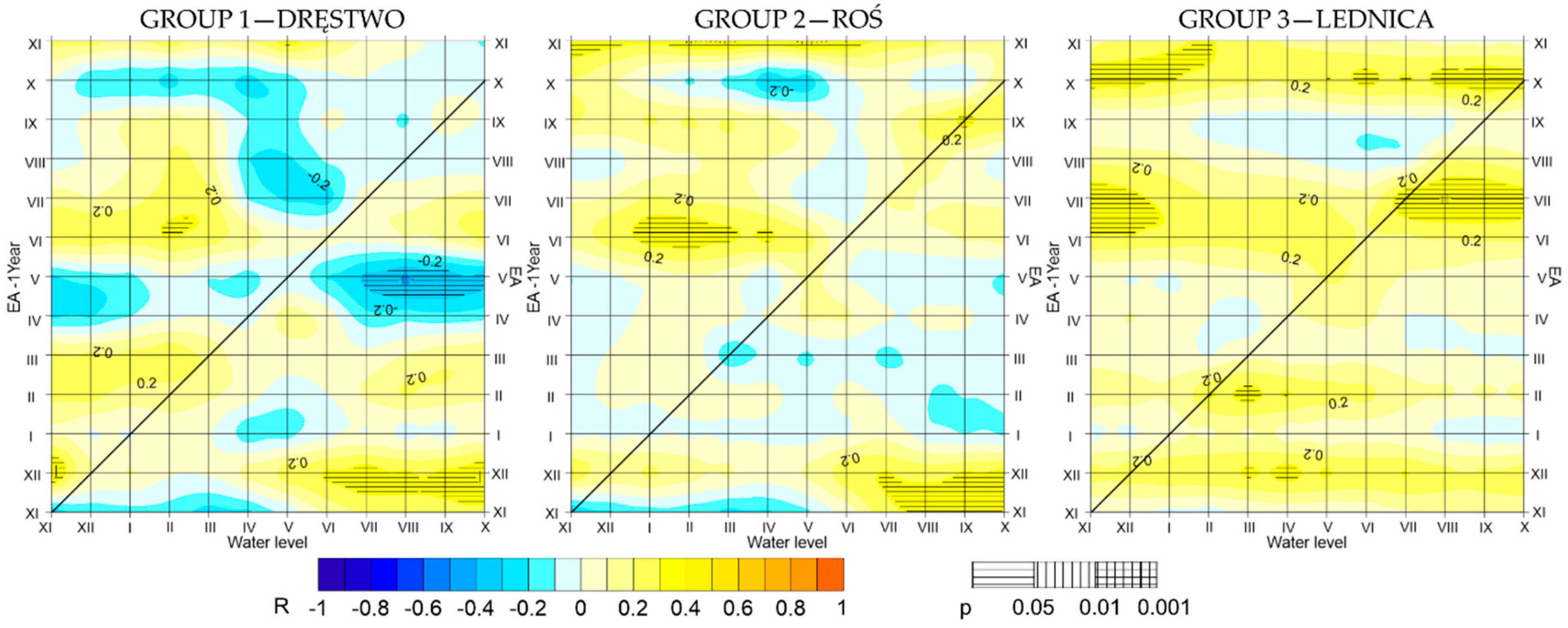
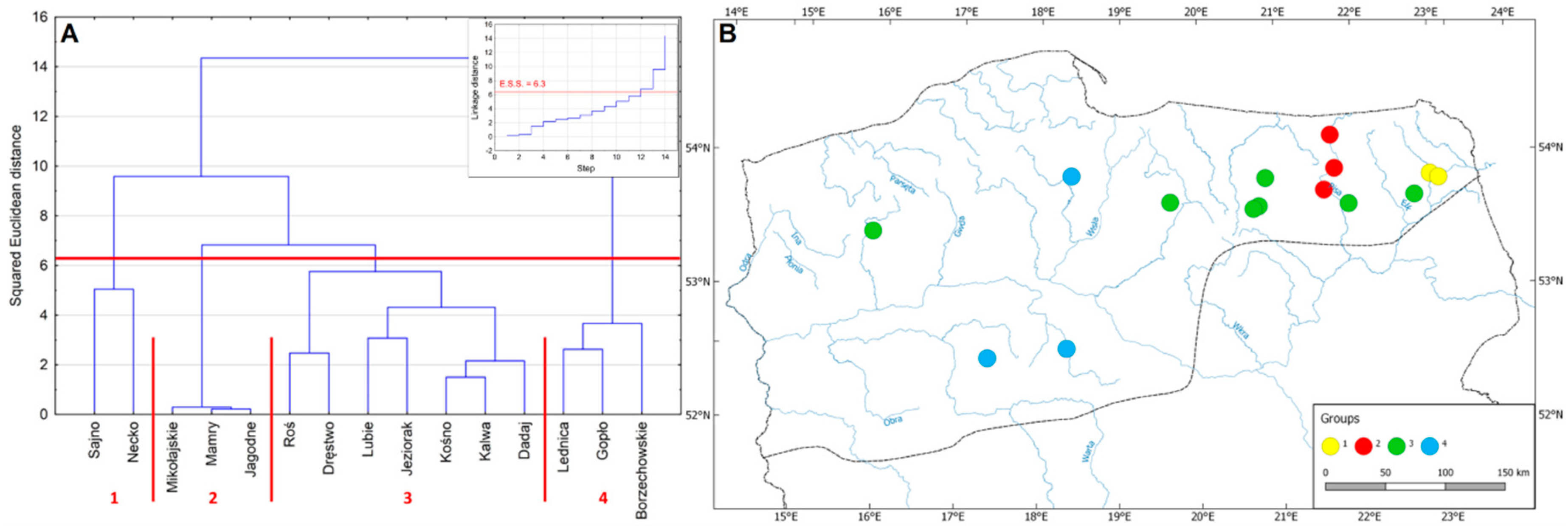
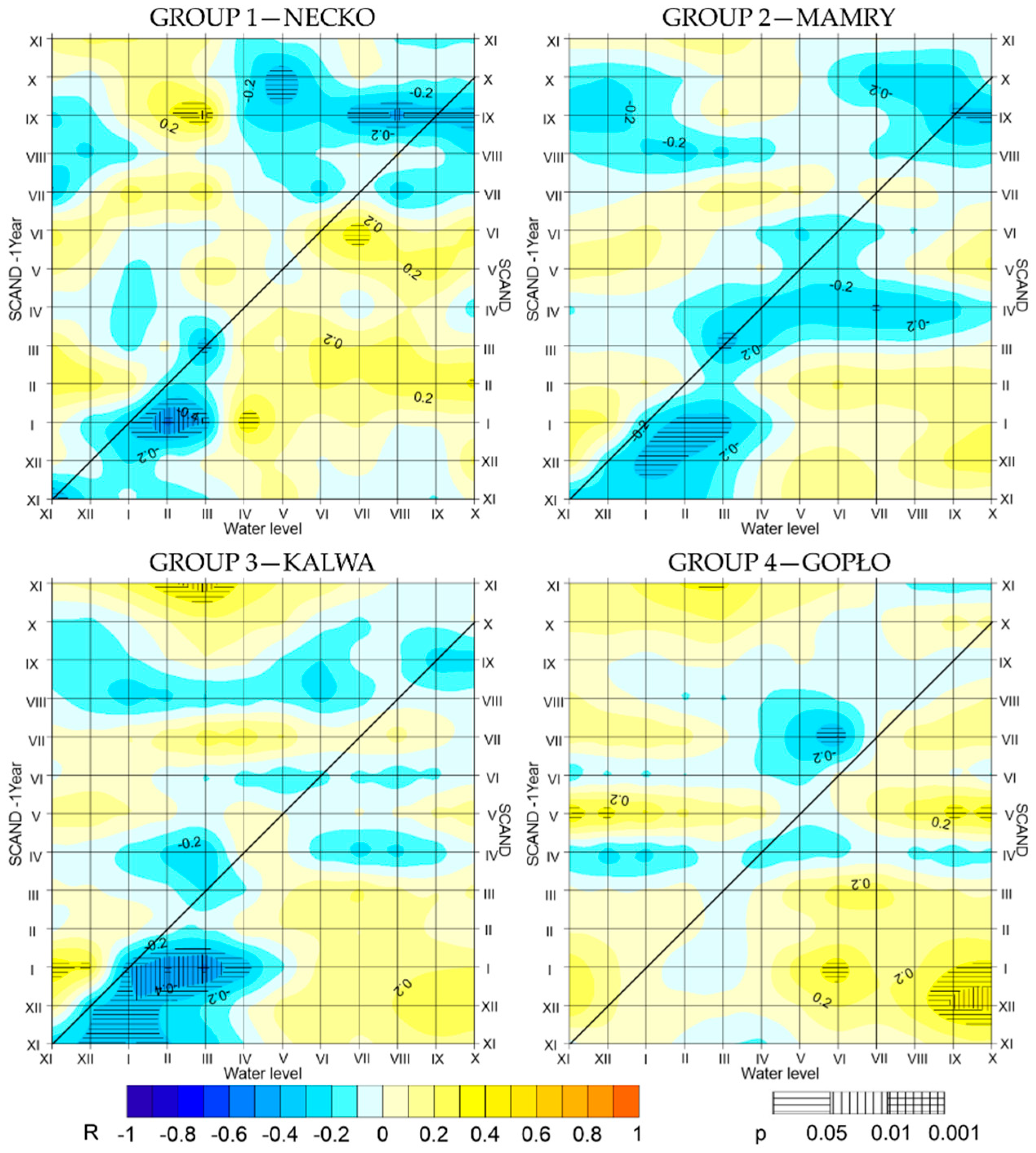
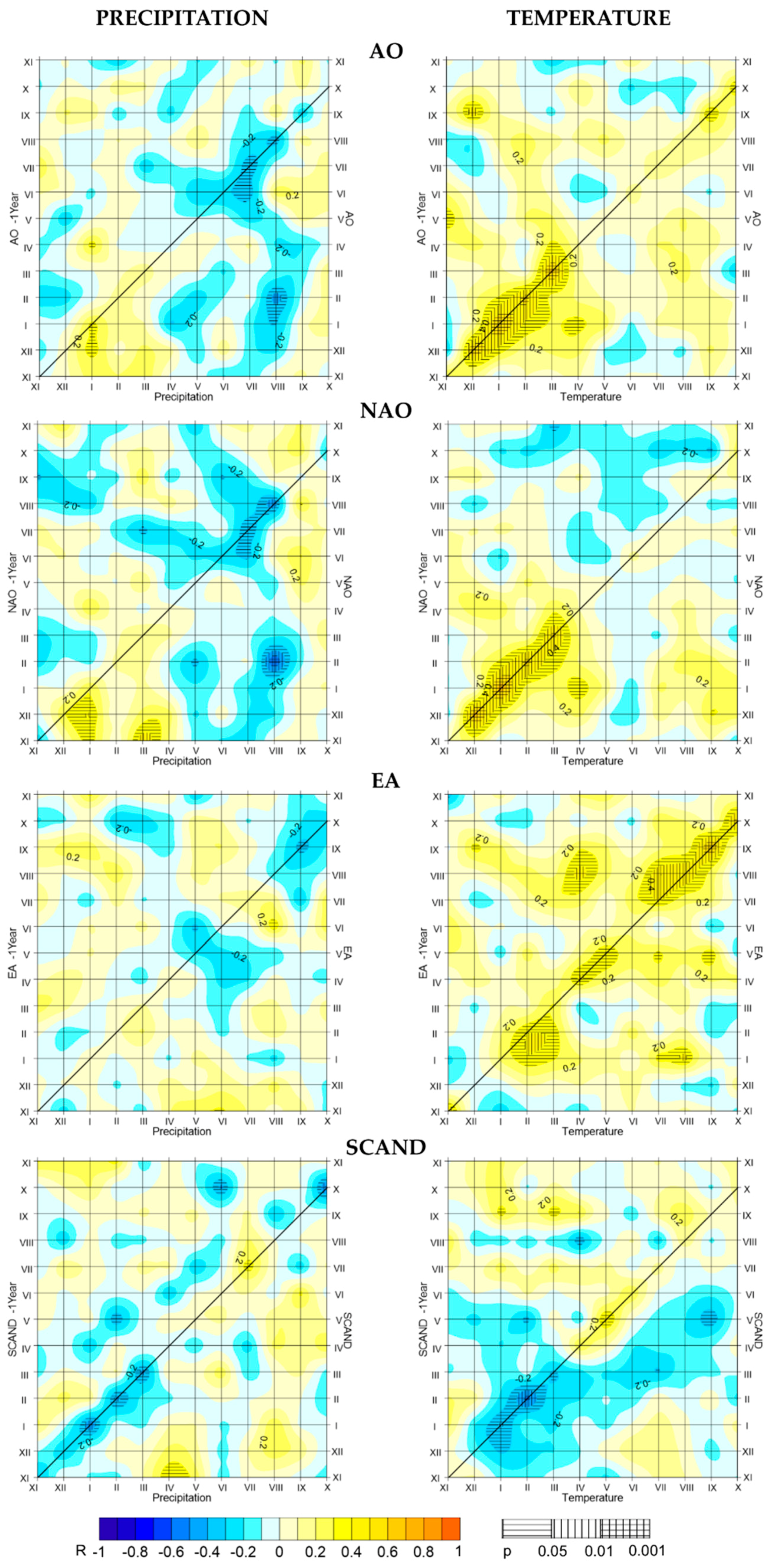
| Lake | Area (ha) 1 | Volume (thousand m3) 1 | Average Depth (m) 1 | Maximum Depth (m) 1 | Coefficient of Variation (Cv) | Amplitudes of Water Level (cm) | Type of Regime 2 | Area of Catchment (km2) 3 | Schindler Index (m−1) | Ohle Index (-) | Elements of the Water Balance of Lake Catchment | Water Exchange Rate α | |||
|---|---|---|---|---|---|---|---|---|---|---|---|---|---|---|---|
| Annual Max | Annual Mean | Extreme Multi-Year | Outflow (mm) 4 | Precipitation (mm) 5 | |||||||||||
| Lubie | 1487.5 | 169,880.5 | 11.6 | 46.2 | 0.061 | 65 | 71 | 84 | 3a | 780.86 | 4.60 | 52.49 | 215 | 660 | 0.99 |
| Lednica | 325.0 | 24,397.0 | 7.0 | 15.1 | 0.173 | 118 | 58 | 186 | 3c | 43.14 | 1.77 | 13.27 | 100 | 540 | 0.18 |
| Gopło | 2121.5 | 78,497.0 | 3.6 | 16.6 | 0.152 | 226 | 87 | 273 | 4b | 1151.26 | 14.67 | 54.27 | 95 | 505 | 1.39 |
| Borzechowskie | 240.0 | 27,002.0 | 11.0 | 43.0 | 0.132 | 49 | 29 | 74 | 3c | 17.25 | 0.64 | 7.19 | 210 | 630 | 0.13 |
| Jeziorak | 3152.5 | 141,594.2 | 4.1 | 12.9 | 0.017 | 76 | 44 | 90 | 3c | 325.28 | 2.30 | 10.32 | 190 | 620 | 0.44 |
| Kośno | 562.5 | 75,767.3 | 13.7 | 44.6 | 0.063 | 56 | 23 | 56 | 4b | 236.73 | 3.12 | 42.09 | 200 | 600 | 0.62 |
| Kalwa | 561.0 | 39,468.6 | 7.0 | 31.7 | 0.087 | 58 | 33 | 76 | 3b | 75.70 | 1.92 | 13.49 | 195 | 600 | 0.37 |
| Dadaj | 975.0 | 120,784.2 | 12.0 | 39.8 | 0.189 | 141 | 71 | 154 | 4b | 340.08 | 2.82 | 34.88 | 200 | 615 | 0.56 |
| Mikołajskie | 424.0 | 55,739.7 | 11.2 | 25.9 | 0.224 | 64 | 38 | 95 | 3b | 1814.87 | 32.56 | 428.04 | 200 | 595 | 6.51 |
| Mamry | 9851.0 | 1,003,367.5 | 9.8 | 43.8 | 0.106 | 62 | 39 | 92 | 3b | 618.52 | 0.62 | 6.28 | 180 | 600 | 0.11 |
| Jagodne | 872.5 | 82,705.2 | 8.7 | 37.4 | 0.111 | 62 | 39 | 95 | 3b | 518.67 | 6.27 | 59.45 | 205 | 600 | 1.29 |
| Roś | 1808.5 | 152,924.9 | 8.1 | 31.8 | 0.378 | 140 | 88 | 177 | 3a | 3033.07 | 19.83 | 167.71 | 215 | 600 | 4.26 |
| Dręstwo | 549.0 | 42,734.6 | 8.5 | 25.0 | 0.180 | 146 | 96 | 208 | 3a | 827.87 | 19.37 | 150.80 | 160 | 590 | 3.10 |
| Necko | 400.0 | 40,561.4 | 10.1 | 25.0 | 0.028 | 106 | 46 | 132 | 2b | 893.54 | 22.03 | 223.39 | 180 | 600 | 3.97 |
| Sajno | 494.0 | 52,446.8 | 10.0 | 27.0 | 0.116 | 161 | 90 | 183 | 2b | 959.78 | 18.30 | 194.29 | 180 | 600 | 3.29 |
© 2019 by the authors. Licensee MDPI, Basel, Switzerland. This article is an open access article distributed under the terms and conditions of the Creative Commons Attribution (CC BY) license (http://creativecommons.org/licenses/by/4.0/).
Share and Cite
Plewa, K.; Perz, A.; Wrzesiński, D. Links between Teleconnection Patterns and Water Level Regime of Selected Polish Lakes. Water 2019, 11, 1330. https://doi.org/10.3390/w11071330
Plewa K, Perz A, Wrzesiński D. Links between Teleconnection Patterns and Water Level Regime of Selected Polish Lakes. Water. 2019; 11(7):1330. https://doi.org/10.3390/w11071330
Chicago/Turabian StylePlewa, Katarzyna, Adam Perz, and Dariusz Wrzesiński. 2019. "Links between Teleconnection Patterns and Water Level Regime of Selected Polish Lakes" Water 11, no. 7: 1330. https://doi.org/10.3390/w11071330
APA StylePlewa, K., Perz, A., & Wrzesiński, D. (2019). Links between Teleconnection Patterns and Water Level Regime of Selected Polish Lakes. Water, 11(7), 1330. https://doi.org/10.3390/w11071330





